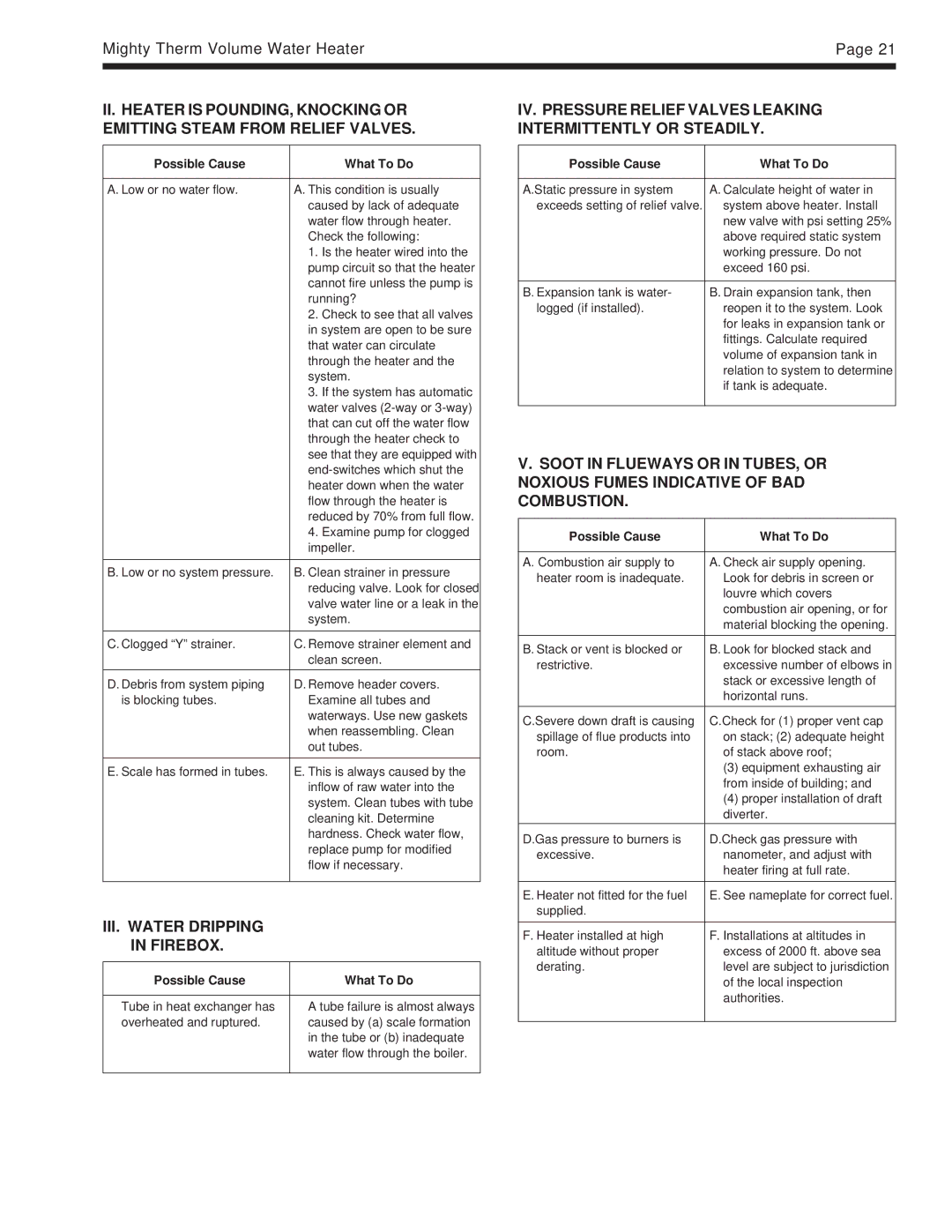Mighty Therm Volume Water Heater | Page 21 |
|
|
|
|
II.HEATER IS POUNDING, KNOCKING OR EMITTING STEAM FROM RELIEF VALVES.
Possible Cause | What To Do |
|
|
A. Low or no water flow. | A. This condition is usually |
| caused by lack of adequate |
| water flow through heater. |
| Check the following: |
| 1. Is the heater wired into the |
| pump circuit so that the heater |
| cannot fire unless the pump is |
| running? |
| 2. Check to see that all valves |
| in system are open to be sure |
| that water can circulate |
| through the heater and the |
| system. |
| 3. If the system has automatic |
| water valves |
| that can cut off the water flow |
| through the heater check to |
| see that they are equipped with |
| |
| heater down when the water |
| flow through the heater is |
| reduced by 70% from full flow. |
| 4. Examine pump for clogged |
| impeller. |
|
|
B. Low or no system pressure. | B. Clean strainer in pressure |
| reducing valve. Look for closed |
| valve water line or a leak in the |
| system. |
|
|
C. Clogged “Y” strainer. | C. Remove strainer element and |
| clean screen. |
|
|
D. Debris from system piping | D. Remove header covers. |
is blocking tubes. | Examine all tubes and |
| waterways. Use new gaskets |
| when reassembling. Clean |
| out tubes. |
|
|
E. Scale has formed in tubes. | E. This is always caused by the |
| inflow of raw water into the |
| system. Clean tubes with tube |
| cleaning kit. Determine |
| hardness. Check water flow, |
| replace pump for modified |
| flow if necessary. |
|
|
III. WATER DRIPPING
IN FIREBOX.
Possible Cause | What To Do |
|
|
Tube in heat exchanger has | A tube failure is almost always |
overheated and ruptured. | caused by (a) scale formation |
| in the tube or (b) inadequate |
| water flow through the boiler. |
|
|
IV. PRESSURE RELIEF VALVES LEAKING INTERMITTENTLY OR STEADILY.
Possible Cause | What To Do |
|
|
A.Static pressure in system | A. Calculate height of water in |
exceeds setting of relief valve. | system above heater. Install |
| new valve with psi setting 25% |
| above required static system |
| working pressure. Do not |
| exceed 160 psi. |
|
|
B. Expansion tank is water- | B. Drain expansion tank, then |
logged (if installed). | reopen it to the system. Look |
| for leaks in expansion tank or |
| fittings. Calculate required |
| volume of expansion tank in |
| relation to system to determine |
| if tank is adequate. |
|
|
V.SOOT IN FLUEWAYS OR IN TUBES, OR NOXIOUS FUMES INDICATIVE OF BAD COMBUSTION.
Possible Cause | What To Do |
|
|
A. Combustion air supply to | A. Check air supply opening. |
heater room is inadequate. | Look for debris in screen or |
| louvre which covers |
| combustion air opening, or for |
| material blocking the opening. |
|
|
B. Stack or vent is blocked or | B. Look for blocked stack and |
restrictive. | excessive number of elbows in |
| stack or excessive length of |
| horizontal runs. |
|
|
C.Severe down draft is causing | C.Check for (1) proper vent cap |
spillage of flue products into | on stack; (2) adequate height |
room. | of stack above roof; |
| (3) equipment exhausting air |
| from inside of building; and |
| (4) proper installation of draft |
| diverter. |
|
|
D.Gas pressure to burners is | D.Check gas pressure with |
excessive. | nanometer, and adjust with |
| heater firing at full rate. |
|
|
E. Heater not fitted for the fuel | E. See nameplate for correct fuel. |
supplied. |
|
|
|
F. Heater installed at high | F. Installations at altitudes in |
altitude without proper | excess of 2000 ft. above sea |
derating. | level are subject to jurisdiction |
| of the local inspection |
| authorities. |
|
|
